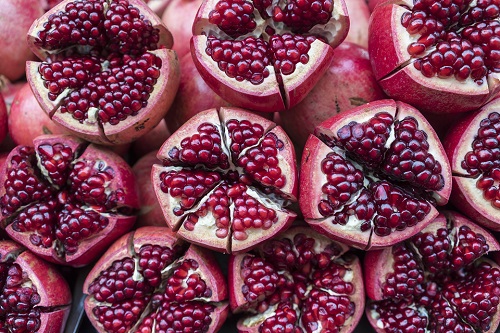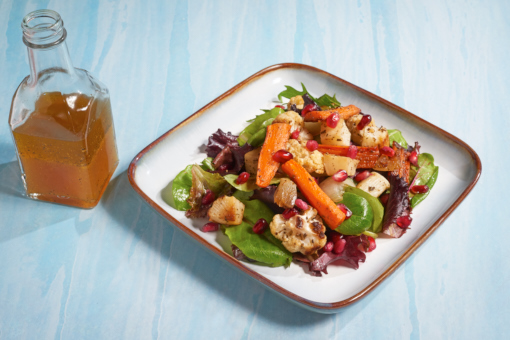Food Facts Friday: Pomegranates

The holiday season is upon us with the final leaves falling down and the snow starting to fall. The wintery wonderland of the holidays with gatherings of family, friends and delicious foods. Pomegranates are one of those holiday favorites and are in season in the Northern Hemisphere from October to February. This fruit is known as the “The Jewel of Autumn,” making it a popular holiday fruit.
Pomegranates are unique and have a reputation of being a healthy fruit containing hundreds of edible seeds called arils, which contain fiber, vitamins, and minerals. With the seeds being the only edible part of the pomegranate, a half a cup of pomegranate contains 72 calories, 3.5 fiber, 205 mg potassium, 12 g natural sugar, and 9 mg vitamin C. There are many positive health claims surrounding pomegranates as a super-food and being good for the body. However, for those patients with kidney disease or who are following a low potassium diet, the potassium content needs to be monitored very closely considering one pomegranate has more potassium than a medium banana. One pomegranate contains 666 mg potassium, while a medium banana contains 422 mg potassium.
Potassium Caution
A normal blood potassium level is between 3.5-5.5 mEq/L. If kidney function decreases, it becomes more difficult to maintain a normal range. As a result potassium can start to build up in the body, a condition known as hyperkalemia. Symptoms of an elevated potassium level may include, weakness, nausea, numbness, and a slow heartbeat. If too much potassium builds up in the body it can affect the heart and be fatal. Ask your doctor or renal dietitian about your monthly blood potassium level and know your numbers. In an effort to prevent potassium blood levels from going too high, limit foods that are high in potassium. Your renal dietitian can help you plan a diet so you are getting the right amount of potassium.
Serving Pomegranate
Although higher in potassium, a limited amount of pomegranate can be included in a lower potassium kidney diet. Two tablespoons contain 52 mg potassium. Add this amount to a serving of winter veggie or fruit salad. Make a festive sparkling drink by adding a few pomegranate arils. Include pomegranate in a yogurt parfait or add to your favorite cereal. Try this Roasted Carrot and Cauliflower Salad recipe that includes pomegranate arils.

Removing Pomegranate Arils
Follow these steps to remove arils (seeds) from a pomegranate.
- Cut the top off the pomegranate.
- With a paring knife, make 6 shallow vertical slices from top to bottom of the fruit.
- Using your hands, gently pry open the pomegranate.
- Remove the seeds from the membrane and peel using your fingers. Hold over a bowl.
- Fill the bowl with water and skim off pieces of membrane. Drain water and store pomegranate arils until ready to serve.
References
- https://www.kidney.org/atoz/content/potassium – accessed 11/29/20
- https://www.nyp.org/documents/nutrition/resources/RenalDietEnglish.pdf – accessed 11/29/20
- https://healthyeating.sfgate.com/health-benefits-pomegranate-4224.html – accessed 11/29/20
- https://www.thespruceeats.com/all-about-pomegranates-4077055#:~:text=Pomegranate%20trees%20need%20plenty%20of,even%20into%20January%20some%20years. – accessed 11/29/20
Additional Kidney Diet Resources
Visit DaVita.com and explore these diet and nutrition resources:
- DaVita Food Analyzer
- DaVita Dining Out Guides
- Today’s Kidney Diet Cookbooks
- DaVita Kidney-Friendly Recipes
- Diet and Nutrition Articles
- Diet and Nutrition Videos
- Kidney Smart® Virtual Classes
This article is for informational purposes only and is not a substitute for medical advice or treatment. Consult your physician and dietitian regarding your specific diagnosis, treatment, diet and health questions.

Recent Comments